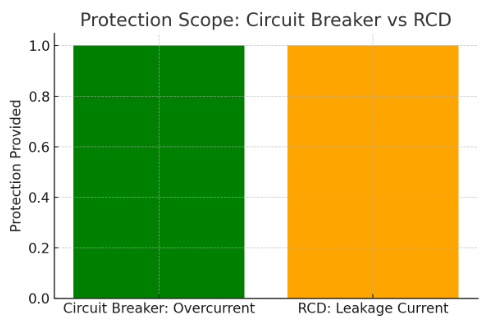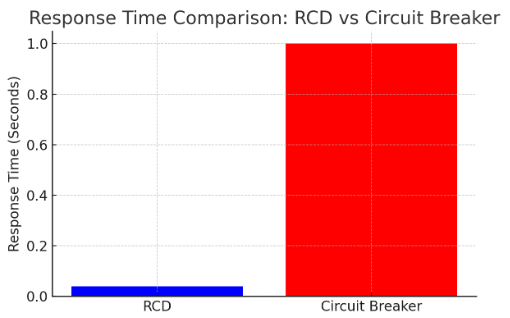In modern electrical systems, safety is paramount, and two devices that play a crucial role in ensuring that safety are circuit breakers and Residual Current Devices (RCDs). Both are designed to protect your home or business from electrical faults, but they each serve a very different purpose. Understanding how they work and the unique protection they offer is essential for maintaining a safe and compliant electrical system.
What Is a Circuit Breaker?
A circuit breaker is an automatic safety device designed to protect an electrical circuit from damage caused by overcurrent, such as short circuits or overloads. These conditions can occur when there is an excessive current flowing through the circuit, which may cause wires to overheat, potentially leading to fires or damaging appliances.
How Does a Circuit Breaker Work?
Circuit breakers use either thermal or electromagnetic mechanisms to detect faults:
Thermal protection works when the current exceeds a preset level for a certain time. The heat generated trips the breaker.
Electromagnetic protection responds more quickly to sudden surges in current, such as in the case of a short circuit.
Once the breaker trips, it interrupts the current flow to prevent any further damage. After the problem is resolved, you can simply reset the breaker to restore the flow of electricity.
Types of Circuit Breakers
Circuit breakers come in various types depending on their application and the amount of current they need to handle:
Miniature Circuit Breakers (MCBs): Commonly found in residential settings, these protect against short circuits and overloads.
Molded Case Circuit Breakers (MCCBs): Used for larger industrial applications where higher currents are involved.
Residual Current Circuit Breakers (RCCBs): These combine circuit protection with residual current detection, merging the functions of both devices.
What Is an RCD (Residual Current Device)?
An RCD (Residual Current Device) is a safety device that detects residual currents—that is, when the current flowing through the live and neutral conductors is out of balance. This imbalance may occur if electricity is leaking somewhere it shouldn't be, such as through a person who has come into contact with an exposed wire.
How Does an RCD Work?
RCDs are sensitive to minute differences in current between the live and neutral wires. When the RCD detects any leakage or imbalance, it immediately cuts off the power supply, typically within 20-40 milliseconds. This rapid action helps prevent serious electric shocks and reduces the risk of fires caused by leakage currents.
RCDs are commonly used to protect people from electric shock, especially in areas where contact with water is more likely, such as bathrooms, kitchens, and outdoor circuits.
Types of RCDs
There are several types of RCDs, including:
Standard RCDs: Typically installed in the electrical panel to protect all circuits in the system.
Socket-Outlet RCDs: Installed in specific outlets, commonly used in areas with higher risk of shock.
Portable RCDs: Used in temporary or portable applications such as construction sites or outdoor power tools.
Key Differences Between Circuit Breakers and RCDs
While circuit breakers and RCDs are both safety devices, they protect against very different hazards. Let’s take a closer look at the key differences between the two.
1. Purpose of Protection
Circuit Breaker: Protects wiring and equipment from damage due to overcurrent, such as overloads or short circuits.
RCD: Protects people from electric shocks by detecting leakage currents and imbalances between the live and neutral wires.
2. What They Detect
Circuit Breaker: Detects overcurrent conditions—when the current exceeds a preset limit, either due to overloads or short circuits.
RCD: Detects earth leakage—when the amount of current flowing through the live wire is different from the neutral wire, indicating leakage.
3. Response Time
Circuit Breaker: Responds to overcurrent events by tripping the breaker in a matter of seconds or even milliseconds in some cases.
RCD: Responds almost instantly to leakage currents, typically within 20-40 milliseconds, far faster than a circuit breaker, to prevent electric shocks.
4. Areas of Use
Circuit Breaker: Found in all electrical panels and installed for every circuit to ensure that equipment and wiring are protected from overloads or faults.
RCD: Installed in areas where electric shock hazards are a concern, such as bathrooms, outdoor circuits, and kitchen areas. It’s commonly used alongside a circuit breaker for comprehensive protection.


Here are the three charts to visually explain the differences between circuit breakers and RCDs:
Comparison of Circuit Breakers and RCDs: This chart shows the primary function of each device—circuit breakers protect equipment, while RCDs protect people from electric shocks.
Response Time Comparison: This chart compares the response times of an RCD (in milliseconds) and a circuit breaker (in seconds), highlighting the quicker response time of an RCD for electric shock prevention.
Protection Scope Comparison: This chart illustrates the different types of protection offered—circuit breakers protect against overcurrent, while RCDs protect against leakage current.
Why Are Both Circuit Breakers and RCDs Important?
Although both devices protect against electrical faults, they protect against different risks. Circuit breakers are essential for protecting the infrastructure of your electrical system, including the wiring and connected devices, from damage caused by excessive current. On the other hand, RCDs offer protection against the more immediate threat of electric shock.
Using both devices ensures that your home or business is protected against both electrical fires and human injury. It’s important to remember that a circuit breaker alone won’t stop you from being shocked by an exposed wire, and an RCD won’t prevent damage from an overload.
Combined Protection: RCBO
For added convenience, there are RCBOs (Residual Current Breaker with Overcurrent Protection), which combine the functions of both an RCD and a circuit breaker. This all-in-one unit protects against both overcurrent (circuit breaker function) and leakage current (RCD function) in a single device.
Applications in Residential and Commercial Settings
In the Home
In residential electrical systems, circuit breakers are essential for protecting the circuits from overloads, while RCDs are typically used in high-risk areas like bathrooms and kitchens, where the risk of electric shock is higher due to the presence of water.
In Commercial and Industrial Settings
In commercial and industrial environments, circuit breakers and RCDs are often installed to protect workers and equipment. MCCBs (Molded Case Circuit Breakers) and industrial RCDs are used in larger systems, while portable RCDs are often used for construction sites to protect workers from accidental electrocution.
Conclusion
Both circuit breakers and RCDs play crucial roles in ensuring electrical safety, but they work in very different ways. Circuit breakers are designed to protect the wiring and equipment from damage caused by overcurrent, while RCDs protect people from electric shocks by detecting leakage currents.
Together, they offer comprehensive protection. It’s essential to understand the differences and functions of these devices to ensure your electrical systems are as safe as possible, whether in a home, office, or industrial setting.






